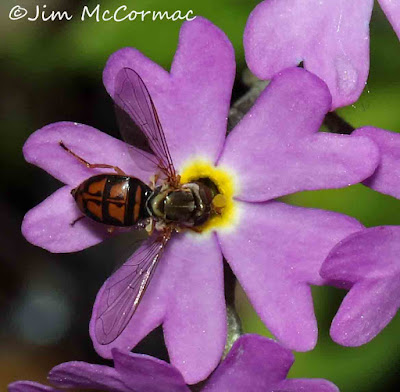A harlequin-patterned Lark Sparrow forages on rocky ground in the lunar landscape of a long-abandoned limestone quarry in Greene County. This handsome sparrow is at the eastern limits of its breeding range in Ohio, and is very rare here.
Taking a brief pause from its teeter-tottering gait to regard the photographer, this Spotted Sandpiper was one of several nesting along artificial pools in the same quarry as the Lark Sparrow above. The little pink flowers bookending the sandpiper are Branching Centaurium, Centaurium pulchellum, a showy little Eurasian weed.
This close-up of the flower of a Prairie Fringed Orchid, Platanthera leucophaea, reveals Edvard Munch's character in The Scream, wearing a bonnet. The orchid is among the rarest of the rare, one of only six Federally Threatened plants found in Ohio. Prairie remnant in Clark County.
A hard-working Cliff Swallow crafts its adobe igloo under a Clark County bridge. This species has increased by about 200% in the last 25 years, and now nests under many if not most large bridges in Ohio. Cliff Swallows are normally single-brooded. Nest construction at this late date is probably due to the original nest getting destroyed.
A female Elfin Skimmer balances gracefully atop a Walking Spikerush, Eleocharis rostellata. Both the dragonfly and the plant are rarities in Ohio, but the dragonfly is the rarer of the two. It is listed as endangered. Cedar Bog, in Champaign County.
This is the male Elfin Skimmer, which little resembles the female, at least in coloration. It is obelisking - pointing its abdomen directly at the sun to minimize heat absorption. The temperature was about 93 F when I made the image. Cedar Bog.
I ran into Alex Patton and Kathy Cubert at Cedar Bog, and as we meandered along the boardwalk, Alex spotted this cluster of stinkbug - or some related hemipteran - eggs on the underside of a leaf. Bonus! A tiny 1-2 mm long parasitoid wasp, perhaps in the genus Trissolcus, tends the eggs. She has or will puncture most if not all eggs, and deposit her own eggs within the host's eggs. The wasp larvae will feast on the contents. Wasp - 1. Stinkbug - 0.
Rich granular anthers dangle from pendant filaments - the business end of a Michigan Lily, Lilium michiganense, flower. This is a great year for these large showy lilies at Cedar Bog, and if you wish to see them in their full splendor, head over there this coming weekend.
A female Eastern Bluebird tries to wrestle a large female Widow Skimmer dragonfly into her fencepost nest. She did, eventually, and then spent some time within the cavity, no doubt slicing and dicing the large tough insect so that tiny nestlings could handle it. Muskingum County.
Shy and furtive, a Yellow-billed Cuckoo briefly pops from the dense foliage of a Honey Locust. Cuckoos are incredibly common in regions that experienced the Brood V 17-year cicada emergence. On this day I heard or saw two dozen or so, including many Black-billed Cuckoos. It's not only cuckoos that feast on the cicadas. I've seen American Robins and Red-winged Blackbirds flycatching for them, a Northern Cardinal eating one, and the previously mentioned bluebird brought one back to her nest.
One of our most striking butterflies, the Zebra Swallowtail. This one is nectaring at Butterfly Milkweed, and was one of about six fluttering around the plant. These black-and-white butterflies seem to be present in large numbers this summer.





















































